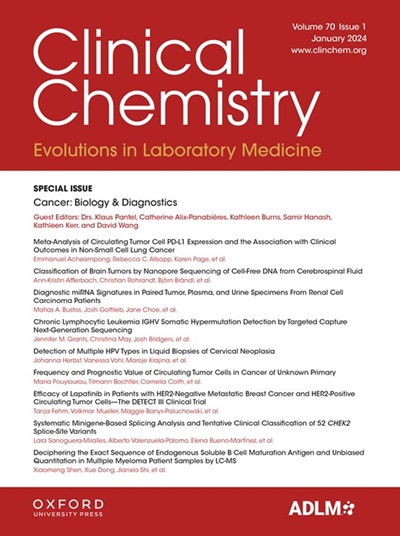Pediatric Vaccine-Induced Antibody Thresholds: Rethinking Pre-Immunosuppression Serologic Testing and Revaccination Implications
IF 7.1
2区 医学
Q1 MEDICAL LABORATORY TECHNOLOGY
引用次数: 0
Abstract
Background Immune response to vaccination is assessed when adequate vaccine protection is in question or immunosuppression is imminent through measurement of antibody levels, which wane as time from vaccination increases. The serologic cutoff value for adequate response is based on thresholds derived from studies in adults, and age-appropriate thresholds for children have not been established. We sought to investigate age-specific differences in antibody levels in healthy children to guide determination of vaccine immunity status when clinically indicated. Methods This cross-sectional study assessed clinical serology for measles, mumps, rubella (MMR), varicella, and hepatitis B (HepB) in an age-stratified cohort of 471 healthy children who were up to date for vaccination (1 to 18 years). Remnant specimens with sufficient volume were collected from July 23, 2019, to November 17, 2020, as convenience samples and chart reviewed for inclusion. Results While children of all ages had detectable titers to MMR, median titers for HepB and varicella waned by ages 11 to 12 and 9 to 10 years, respectively. Children had titers above adult thresholds for MMR at all measured timepoints, retrospectively resulting in 24.6% (95% CI, 21.6%–27.8%) of children having an inappropriate MMR classification when adult instead of pediatric thresholds were used. Current use of HepB and varicella serology may be inappropriate due to the rapid waning of titers. The adequacy of an individual’s response to one vaccine component did not infer adequate responses to other components. Conclusions Application of age-appropriate reference intervals for vaccine serologic tests will provide a foundation for improved treatment recommendations and standards of care.儿童疫苗诱导的抗体阈值:重新思考免疫抑制前血清学检测和重新接种的意义
背景:当疫苗保护不充分或免疫抑制迫在眉睫时,通过测量抗体水平来评估疫苗接种的免疫反应,抗体水平随着接种时间的增加而减弱。充分反应的血清学临界值是基于成人研究得出的阈值,儿童的适龄阈值尚未确定。我们试图研究健康儿童抗体水平的年龄特异性差异,以指导临床指征时疫苗免疫状态的确定。方法:本横断面研究评估了471名年龄分层的健康儿童的麻疹、腮腺炎、风疹(MMR)、水痘和乙型肝炎(HepB)的临床血清学,这些儿童均已接种疫苗(1至18岁)。2019年7月23日至2020年11月17日,采集足够体积的残标本,作为方便样本,审查纳入图表。结果所有年龄段的儿童均可检测到MMR抗体滴度,但HepB和水痘的中位滴度分别在11至12岁和9至10岁时下降。在所有测量的时间点,儿童的滴度都高于成人的MMR阈值,回顾性分析,当使用成人阈值而不是儿童阈值时,导致24.6% (95% CI, 21.6%-27.8%)的儿童存在不适当的MMR分类。目前使用乙肝和水痘血清学可能是不合适的,因为滴度迅速下降。个人对一种疫苗成分的反应是否充分并不意味着对其他成分的反应是否充分。结论:适用与年龄相适应的疫苗血清学检测参考区间将为改进治疗建议和护理标准提供基础。
本文章由计算机程序翻译,如有差异,请以英文原文为准。
求助全文
约1分钟内获得全文
求助全文
来源期刊

Clinical chemistry
医学-医学实验技术
CiteScore
11.30
自引率
4.30%
发文量
212
审稿时长
1.7 months
期刊介绍:
Clinical Chemistry is a peer-reviewed scientific journal that is the premier publication for the science and practice of clinical laboratory medicine. It was established in 1955 and is associated with the Association for Diagnostics & Laboratory Medicine (ADLM).
The journal focuses on laboratory diagnosis and management of patients, and has expanded to include other clinical laboratory disciplines such as genomics, hematology, microbiology, and toxicology. It also publishes articles relevant to clinical specialties including cardiology, endocrinology, gastroenterology, genetics, immunology, infectious diseases, maternal-fetal medicine, neurology, nutrition, oncology, and pediatrics.
In addition to original research, editorials, and reviews, Clinical Chemistry features recurring sections such as clinical case studies, perspectives, podcasts, and Q&A articles. It has the highest impact factor among journals of clinical chemistry, laboratory medicine, pathology, analytical chemistry, transfusion medicine, and clinical microbiology.
The journal is indexed in databases such as MEDLINE and Web of Science.
 求助内容:
求助内容: 应助结果提醒方式:
应助结果提醒方式:


